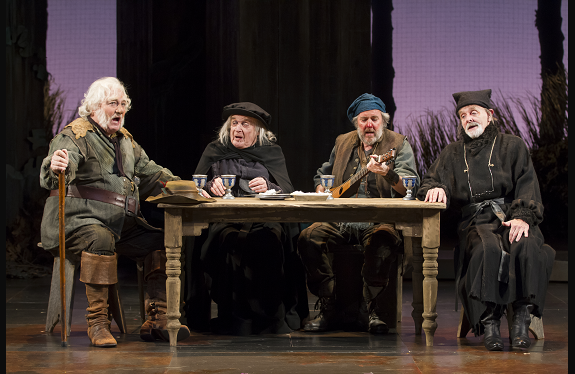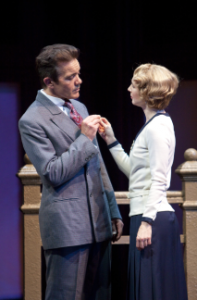Jordan Wright
April 18, 2014
Special to The Alexandria Times
 Matthew Amendt as Prince Hal and Edward Gero as King Henry IV production of Henry IV, Part 2. Photo by Scott Suchman. Right after the gloom and doom set up in Act 1 when we learn that King Henry IV is the target of Wales’ and Scotland’s revenge for his crime of treason, the play begins to open up to comedic relief when Falstaff and Henry’s son, Hal, enter together. And that’s a good thing because, notwithstanding the haunting opening set design by Alexander Dodge in which a giant silhouetted map of the territories is displayed, the play gets off to a complicated enough start with a blast of lightening quick repartee between the King, John of Lancaster and the Earl of Westmoreland. It’s enough to rock any unprepared playgoer back on their heels who might not know the lay of the land, so to speak. And remember, it’s all about the land, the King’s tormented conscience for stealing Mortimer’s rightful throne and his crusade to make things right, that goes horribly wrong. “Uneasy lies the head that wears a crown.” Even Prince Hal has that figured out.
Stacy Keach returns to the Shakespeare Theatre Company as the grandiloquent Falstaff, cohort and amigo-in-arms to the King’s son, Henry the Prince of Wales aka Hal and/or Harry. Falstaff, one of the most enduring and sympathetic characters in all of Shakespeare, is as lovable a scallywag and epitome of a crusty ne’er-do-well as has ever existed in theatredom. And Keach plays him to the hilt, embracing every line, morphing into the character, and flat out owning the role. The man is marvelous. (In one irreverent scene at Henry’s London apartment, he finds a pair of ladies underwear in Hal’s bed and uses them to dab his lips after a meal. You get the picture.) Alas, poor Falstaff, ever the underdog, is repeatedly called every colorful name in describing his ungainly figure, “That huge bombard of sack, that stuffed cloak-bag of guts, that roasted Manningtree ox,” Hal affectionately calls him.
 Stacy Keach as Falstaff and Maggie Kettering as Doll Tearsheet – production of Henry IV, Part 2. Photo by Scott Suchman. There is much to praise about Shakespeare Theatre Company’s engaging two-night presentation, the exquisite costumes of silk, fur, leather and chainmail by Ann Hould-Ward, the sword fighting direction by Rick Sordelet and Christian Kelly-Sordelet, original period-inspired music composed by Michael Roth, including a tender Welsh ballad sung by Lady Mortimer (Vanessa Sterling), and especially the remarkably magnetic Matthew Arendt who plays Prince Hal. Arendt brims with irresistible charm keeping the energy level, as well as the cast, in high gear.
 Stacy Keach as Falstaff, Ted van Griethuysen as Justice Shallow, Brad Bellamy as Bardolph, and Bev Appleton as Justice Silence in production of Henry IV, Part 2. Photo by Scott Suchman. Other standouts are Craig Wallace, who gives an elegant portrait of the swaggering Earl of Westmoreland, John Keabler as the sexiest Hotspur alive, Kelley Curran as his wife, Lady Percy, as alluring a liberated woman as ever there was, and of course, Edward Gero in the powerhouse role of Henry IV. Look for scene-stealer Ted van Griethuysen who simply kills it as Justice Shallow in Part 2.
Highly recommended.
Through June 8th at Sidney Harmon Hall, 610 F Street NW, Washington, DC 20003. For tickets and information contact the Box Office at 202 547-1122 or visit www.shakespearetheatre.org.
 Matthew Amendt as Prince Hal, Patrick Vaill as Lancaster, and Nathan Winkelstein as Gloucester in production of Henry IV, Part 2. Photo by Scott Suchman.
Jordan Wright
January 28, 2014
Special to The Alexandria Times
 Siân Phillips as Lady Bracknell in the Shakespeare Theatre Company’s production of The Importance of Being Earnest, directed by Keith Baxter. Photo by Scott Suchman. It is always satisfying to while away the hours at the theater, but it is most especially pleasurable to let playwright and poet Oscar Wilde remind us of the imbroglios of the Upper Class in Victorian England. In this delightful piece of froth we are allowed a glimpse behind the looking glass of London society.
Algernon Moncrieff is a terminably bored dandy with a grand sense of getting up to no good. His avatar is a naughty character he calls “Bunbury”. Algy’s equally ne’er-do-well friend Jack Worthing, trumps himself up as “Earnest”, a man caring for a beautiful young ward, Cecily, whose care has been entrusted to him by a relative.
 Gregory Wooddell as Jack and Vanessa Morosco as Gwendolen in The Importance of Being Earnest, directed by Keith Baxter. Photo by Scott Suchman. The merriment begins when Algy’s aunt, Lady Bracknell and her niece Gwendolyn Fairfax arrive at his fashionable West End home for a visit. When Jack declares his intention to marry Gwendolyn, who prefers the name Earnest, “It produces vibrations,” she admits, the frolic begins. Lady Bracknell, who delivers all of her high-minded remarks as pronouncements, feels it is her duty to grill him on his social standing. Discovering that he was a foundling discovered ignobly in a railroad station, she gives him short shrift, despite his fortune.
When Algy races off behind his friend’s back to woo Cecily, he portrays himself as Earnest too. Cecily assures him that she too could only marry a man named Earnest to which he replies, “What if my name were Algernon? It’s a very aristocratic name. Half the chaps that get into bankruptcy courts are named Algernon!” Yet both she and Gwendolyn remain firm in their convoluted determination.
 Gregory Wooddell as Jack and Patricia Conolly as Miss Prism in The Importance of Being Earnest, directed by Keith Baxter. Photo by Scott Suchman. The how, when, and wherefore of the gentlemen’s love lives may be what turns the plot. But it’s the steady repartee, quaint in its moralistic rhetoric and added to the hilarious misunderstandings, that renders the play irresistible. Forgetfulness is referred to as “mental abstraction” and arguments are considered “vulgar and often convincing”. It’s a topsy-turvy Wodehouseian world.
Sian Phillips, a veteran of the BBC’s “I, Claudius” series, imbues Lady Bracknell with the steely demeanor of a true Victorian matriarch; Anthony Roach crafts a delightfully whimsical Algernon; Gregory Wooddell plays Worthing effortlessly and Patricia Conolly, as Cecily’s governess, the self-righteous Miss Prism, creates the perfect foil for the rest of the cast.
Flawless and fabulous.
Though March 9th at the Lansburgh Theatre, 450 7th Street NW, Washington, DC 20003. For tickets and information contact the Box Office at 202 547-1122 or visit www.shakespearetheatre.org.
 Gregory Wooddell as Jack and Anthony Roach as Algernon in The Importance of Being Earnest, directed by Keith Baxter. Photo by Scott Suchman.
Jordan Wright
June 27th, 2011
Special to The Alexandria Times
 The cast and set of the Shakespeare Theatre Company’s production of The Merchant of Venice, directed by Ethan McSweeny. Photo by Scott Suchman. From the start the Shakespeare Theatre Company’s version of The Merchant of Venice crackles with electricity amid the hustle-bustle of a large commerce-driven metropolis. On a one-size-fits-all set, trisected by levels and diagonalized by a sweeping three-story staircase, booze-fueled revelers burst through a set of wooden doors in a crazed conga line as they whirl past the train station’s café and into the ether of billowing locomotive steam. The set seems lifted from the Main Concourse at Grand Central Station in New York City, and that’s a good thing because this version of Shakespeare’s familiar tragicomedy has been shapeshifted into The Jazz Age of the 1920’s and launched into the era of hot flappers and cool bathtub gin.
 Derek Smith as Antonio and Julia Coffey as Portia in the Shakespeare Theatre Company’s production of The Merchant of Venice, directed by Ethan McSweeny. Photo by Scott Suchman. In a sweeping reinterpretation of the characters by Director Ethan McSweeney, the beguiling Portia is depicted as a horseback riding, golf-playing heiress and The Prince of Arragon as a mincing, Pekinese-toting yachtsman. In this version of the classic tale, Antonio, the cocksure privateer, becomes a self-absorbed commodities trader and The Prince of Morocco, an aviating daredevil playboy. Try envisioning The Little Prince on Viagra.
On a more serious note, Evans’ Shylock shows a grim yet brilliant accuracy…an accuracy that can get you blackballed in the Jewish community. His portrayal of the vengeful moneylender, written as the quintessentially unflattering stereotype of an Orthodox Jew, one whose sense of justice outweighs his sense of mercy, is unflinching. The outcast, as it was written, is a despicable man worthy of inclusion in a Nazi propaganda film short. It’s no wonder Theodore Bikel turned the role down and Evans is thought to be the first Jew ever to accept it. But stop a moment to recognize its worth in the play, it’s no more and no less than a racist characterization and there are countless plays and ethnically-correct actors cast in these thorny roles daily.
Keeping to the new pattern, regional New York and British accents are cleverly tweaked to fit by dialogue coach Deena Burke, with Gratiano, Salerio and Solanio as Bowery Boys; the Duke of Venice as a dese-dem-and-dose mobster; Shylock as a Yiddish-accented Hassidim straight out of Williamsburg, Brooklyn; and Portia as an upper crust Brit on a charm mission. Reattach the untinkered-with script, et voila! a fresh new dynamic. Shakespeare meets F. Scott Fitzgerald on the Lower East Side of Venice.
 Tim Getman as Solanio and Andy Murray as Solario in the Shakespeare Theatre Company’s production of The Merchant of Venice, directed by Ethan McSweeny. Photo by Scott Suchman. Composer Stephen Cahill reinforces the aura with music from the 1920’s, using sultry horns, Charlestonian rhythms and golden standards while Lightning Director Marcus Doshi manages to bring an amber-tinted intimacy to the enormous set, while Jennifer Moeller’s does justice with movie star beaded satin dresses and chic riding attire that share the stage with gangster-style zoot suits, Orthodox Jewish robes and elegant white tie cutaways.
And lest you imagine the production to be tarted up by bold primary colors, knowest all who hearest the proclamation, that the set, designed by Andrew Lieberman, in understated shades of grey, beige and blue, doesn’t distract from the bard’s masterpiece of comedy and still-relevant social drama.
I took as my escort my 13-year old grandson whose knowledge of Shakespeare was A Midsummer’s Night Dream read in dreary black and white (dull compared to the Internet and the technicolor graphics of video games). He was not expecting, nor I, the modernist spin given to the play and sat up with eyes wide open enjoying every action-packed minute of it, most especially the dramatic arrivals of Portia’s suitors.
Bravura performances by Julia Coffey (Portia), Mark Nelson (Shylock), Derek Smith (Antonio), Drew Cortese (Bassanio) and Vaneik Echeverria (The Prince of Arragon). Look for Daniel Pierce to astound in the small role of Launcelot Gabbo.
This is a Merchant with packed with panache and sprinkled with roadsters, radios and champagne toasts.
Five stars.
Through July 24th at the Sidney Harmon Hall, 615 F Street, NW, Washington, DC. For tickets and information call 202 547-1122 or visit www.shakespearetheatre.org.
|










